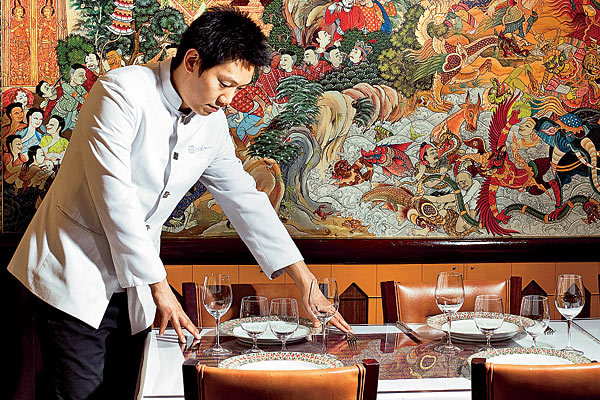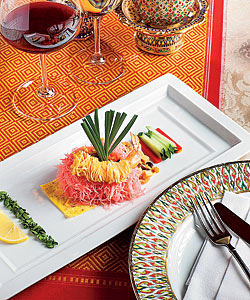
The awe-inspiring décor at Arun’s
Related:
MORE REVIEWS
Allium »
Maison »
Sixteen at the Trump Hotel »
A Toda Madre »
RPM Italian »
Nellcôte »
Balena »
Goosefoot »
Les Nomades »
Bar Toma »
Vera »
Pump Room »
Michael Jordan’s Steak House »
Roka Akor »
Union Sushi + Barbeque Bar »
Antico »
Rustic House »
GT Fish & Oyster »
Perennial Virant »
Next »
Ing »
Crofton on Wells »
Takashi »
L2O »
Chicago Cut Steakhouse » Mastros »
WHAT PENNY EATS »
A photoblog by dining editor Penny Pollack
There’s a dusty file cabinet in this magazine’s offices that tells stories. Leafing through bygone menus and yellowed dining notes, one can trace a restaurant’s entire arc from start to finish, see empires rise, fortunes fail, and once-lofty expectations get boiled down to a simple word: “closed.” My favorite story is about a tiny Thai restaurant that opened in a supposedly jinxed Albany Park storefront in 1985. Chicago sent critics for two early reviews; both came back unimpressed, declaring it pretty but overpriced. The restaurant fell off the radar until a series of letters arrived from its regulars telling the editors they had overlooked a gem. One post card contained only a ten-word message: “This is a place I think you should know about.”
In the next year, our critics visited the place six times, immersing themselves in kaffir lime leaves and lemongrass before finally weighing in at two and a half stars. The food, always ambitious, underwent dramatic changes over the following years, weaving in and out of trends and rising to new levels—thrilling some and incensing others. More than one customer was scandalized by paying $2 for rice. Our file on the restaurant spells out its trajectory, both steep and satisfying, culminating in countless stars, awards, magazine covers, and many thank-you notes to Chicago from a man named Arun Sampanthavivat.
The reason I love the story of Arun’s is because it could have gone in a different direction. Few would have noticed if the place had closed after two years and this fledgling restaurateur with the long name had returned to his original field of academia. Instead, Sampanthavivat, an accidental chef who grew up on a rubber plantation and had no formal culinary training, kept pushing forward in the kitchen. Learning and adjusting. Surviving. And rather than becoming a footnote in a file cabinet, Arun’s grew into the best Thai restaurant in the country, a place so legendary that The New York Times once wrote about Sampanthavivat, “The great chefs go to him to be dazzled.”

Fried prawn wrapped in coconut vermicelli on a sheet of egg omelet at Arun’s
That was 1998. You hear so little about Arun’s these days that no one seemed particularly bothered that Michelin did not deem it worthy of a single star. I recently heard rumors that the place was slipping—or had already fallen—and so I visited on a Saturday night. The orange-toned space, a pristine temple full of Thai murals by Arun’s brother Anawat, was deathly quiet, and I prepared to write an obituary rather than a review. Two hours later, the room was packed, and I realized it was I who was slipping, having lost faith in a proven standout simply because it was 25 years old.
Arun’s is a treasure. There’s still no printed menu, just 12 courses (six appetizers, four shared entrées, and two desserts) at the whim of the kitchen. On my visit, the whims came fast and furious, a series of precise little tableaux appearing every few minutes before downshifting into family-style entrées. Appetizers range from simple and wonderful to complex and wonderful. At the simple end is the sang wa, a potent seafood salad of prawns, scallops, and julienned ginger spikes tossed with kaffir lime and lemongrass vinaigrette—basically a Thai seviche. At the complex end is a brilliant take on a traditional spring roll, filled with tofu and cucumber, drizzled with a punchy sweet-sour tamarind sauce, and draped with Dungeness crabmeat. We asked for heat, and we got it here, mostly in the form of a pickled jalapeño and a dab of slam-bang-spicy mustard. “I want to bathe in that mustard,” my wife said. “I don’t care how much it hurts.”
The tiniest elements amaze, such as Arun’s signature bite-size salad of fresh cha plu (betel nut) leaf wrapped around all kinds of goodies and topped with a tamarind-coconut sauce. You pop it in your mouth and get a burst of coconut—then a squeeze of lime rolls across your tongue until you’re hit with a peanutty, gingery aftershock. This is Willy Wonka stuff, Thai-style. Our waiter said he used to eat this kind of snack on bamboo sticks outside his temple; I may convert to Buddhism just for the food.
Sampanthavivat’s greatest strength is a natural understanding of the interplay between tender and crispy and sweet and salty; sometimes he juggles all four. A golden fried prawn gets wrapped in a cocoon of crisp coconut vermicelli, topped with a creamy coconut and black bean sauce, and bedded on a thin sheet of egg omelet. You’re supposed to mix the rest of the plate (red peppers, cucumbers, tofu, garlic, chives, and lemon) together into a salad. It’s like a painter has given you every color in his palette, and however you spread them, it’s a masterpiece.
THE SKINNY
ARUN’S 4156 N. Kedzie Ave.; 773-539-1909
FYI If you’re a riesling hound, the earnest wine list is a prayer answered.
TAB $85 for a 12-course prix fixe menu
HOURS Dinner Tue. to Sun.
Tab does not include alcohol, tax, or tip.
The family-style entrées never quite hit these peaks, but a shreddy beef tenderloin is as good as ever in a coconut-curry massaman sauce, rich and true. Arun’s has always been a pretty serious place, but a lightly battered red snapper fillet with an addictive chili sauce gets garnished with a carrot that’s been carved to look like the title character in Finding Nemo. The waiter sent it home with us “swimming” in a plastic cup. (The dog barked at it all night.) The kitchen seems less interested in desserts, though the custard atop kabocha squash coulis with a raspberry reduction presses big flavors into a small package. As for service, the language barrier of the past is no more. The entire staff is approachable, smart, and reserved—a welcome respite from the overfamiliar servers populating so many local restaurants right now.
And Sampanthavivat, after a quarter of a century, may be the most beatific man in Chicago. “It’s welcomed,” he says, when I ask about all the foodies who appear to have forgotten his restaurant. “It gives me even more motivation.” On the Michelin snub: “We always appreciate recognition, but that doesn’t bother me. We still do our best.” This is a man who is lying, in denial, or emotionally secure in a way few of us will ever be.
At a time when so many restaurants of this ilk have disappeared or dialed back, Arun’s shines brighter than ever simply by existing and by sticking to its guns. My fondest wish is that its file grows ever thicker in the magical cabinet, even long after I’m gone.


